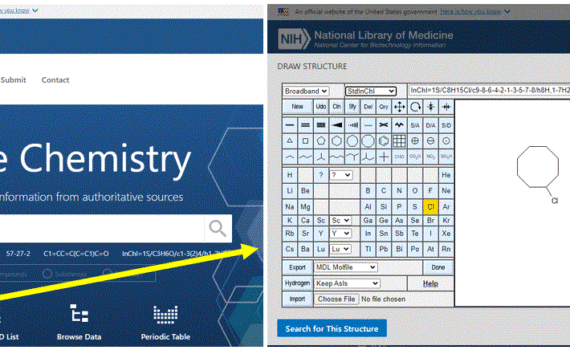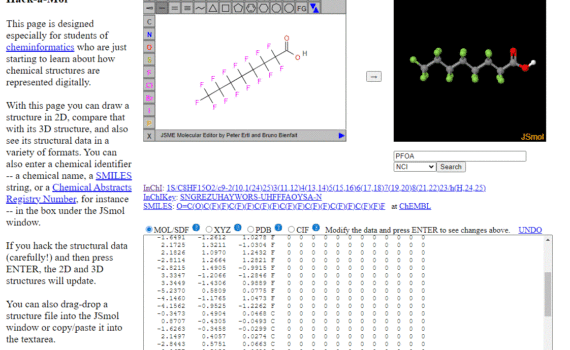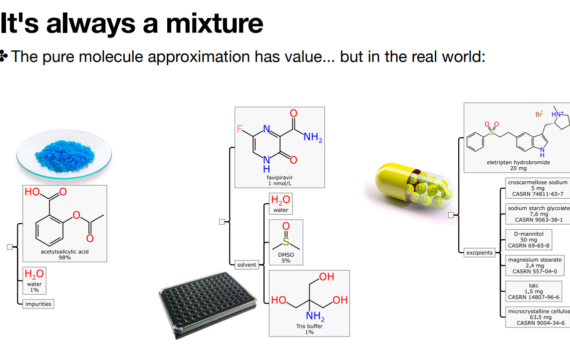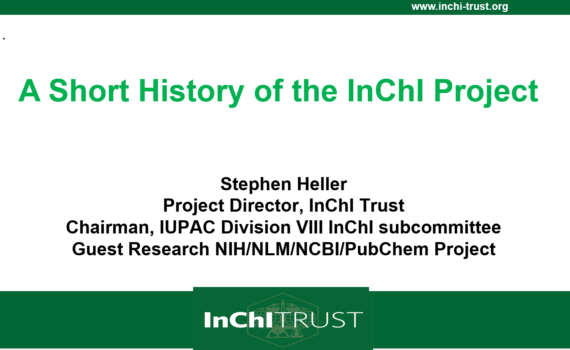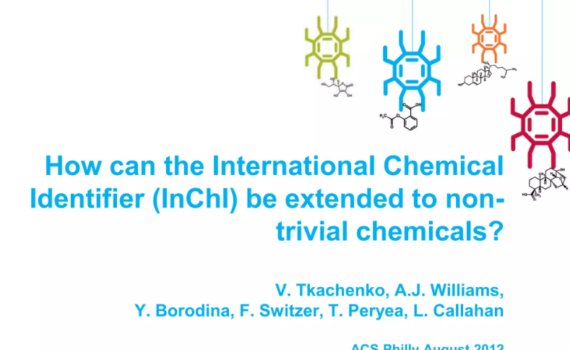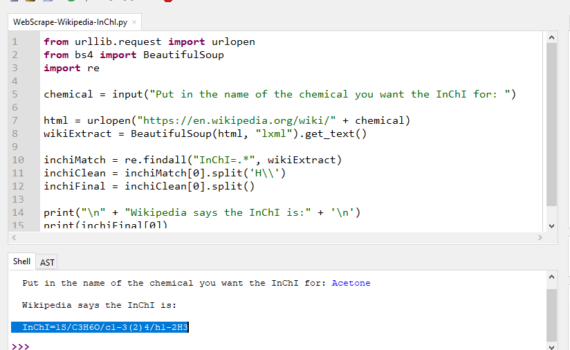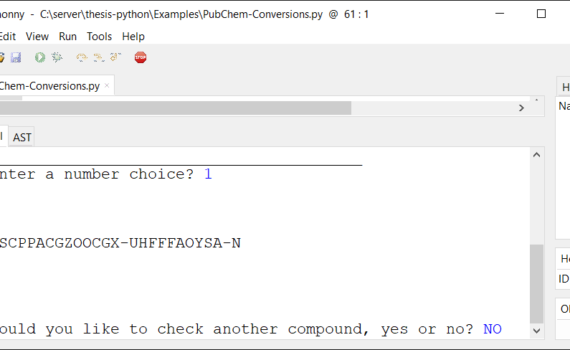The following worksheet and key is designed for organic chemistry students and can download and modified as needed. Learning Objectives: Isotopomers and isotopologues are analogous molecules that differ by isotope composition and/or position within a molecule. Isotopomers have known isotopic position, while isotopologues have unknown isotopic position with a molecule. […]
InChI Tag: Academic Material
Online mixtures demo, with MInChI generator Cheminformatics 2.0 Blog Post, Alex M. Clark The above blog goes over how to use the MInChI Demo MInChI Demo
Abstract: The RInChI is a canonical identifier for reactions which is widely used in reaction databases. It can be used to handle large collections of reactions and to link information from diverse data sources. How much information can it handle? Studies of the SAVI database, which contains more than a […]
A database of chemical structures and identifiers used in the control of WADA Prohibited Substances Description WADA’s role is to help regulate doping internationally working with international sports federations and governments. The list of regulated substances is published annually (https://www.wada-ama.org/en/what-we-do/the-prohibited-list), with substances listed in sub-categories (e.g. stimulants and anabolic agents) […]
WorldFAIR Chemistry – 2. Training Cookbook: Digital recipes for managing chemical data Description This project corresponds to Deliverable 3.2 of the WorldFAIR Chemistry project. The main scope of work will be to develop actionable recipes in the format of a digital Cookbook for how to prepare and deposit FAIR machine-enabled […]
The PubChem chemical structure sketcher Sketcher Direct Link Wolf D Ihlenfeldt, Evan E Bolton & Stephen H Bryant Journal of Cheminformatics volume 1, Article number: 20 (2009) Abstract: PubChem is an important public, Web-based information source for chemical and bioactivity information. In order to provide convenient structure search methods on […]
CheMagic Virtual Molecular Model Kit The CheMagic Virtual Molecular Model Kit was developed by Otis Rothenberger and Jim Web. This molecular editor uses semantic identifiers to connect to a variety on online resources and services. If you click the GetIDdata tab for any chemical in the editor it will provide […]
MolView https://molview.org/ is a web app developed by Herman Bergwerf that uses semantic identifiers like the InChI to connect to chemical information in the cloud. If you go to any molecule and access the “information card” under tools, you will see the InChI and InChI key for that molecule. The […]
Using MolView.org to check your structures in ogranic chemistry Molview is a program developed by Herman Bergwerf that uses InChI and other formats to connect to a variety of web resources. This post is a video created by Wes LeBlanc and is directed towards organic chemistry students. At 52 seconds […]
Hack-a-Mol Hack-a-Mol is a web app Bob Hanson constructed for students interested in cheminformatics. It is an interface that allows you enter names that are searched in PubChem or the NCI Resolver, and then it provides the InChI, InChI Key, SMILES and a connection table of that compound, along with […]
InChIs and Registry Numbers by Jeffery Leigh From the journal Chemistry International — Newsmagazine for IUPAC https://doi.org/10.1515/ci.2012.34.6.23
Progress towards “Large Molecule” support with InChI Evan Bolton,Ph.D. NCI NIH Virtual Workshop on InChI 2021-03-22 Direct Link (Alows you to activate “Full Screen mode” and open as a single slide show)
PubChem: Advancing chemical information through InChI Evan Bolton InChI in the Wild: Celebrating Over 20 years of InChI Development in Memory of InChI Developer Igor PletnevFall 2022 ACS National Meeting2022-08-21 Abstract: The PubChem project (https://pubchem.ncbi.nlm.nih.gov) has been a long time user and contributor to the InChI project. The impact of the InChI project on […]
InChI for Inorganics Alex M. Clark Cheminformatics 2.0 blog September 10, 2019 This blog post goes over extending InChI to inorganic compounds and goes over a variety of bonding patterns that could be of interest to educators. There is also a link to the GitHub that has a lot of […]
Coordination InChI for inorganics: now with stereochemistry Cheminformatics 2.0 blog by Alex Clark October 18, 2020 Cheminformatics 2.0 Blog Post GitHub: Coordination Complexes for InChI: preliminary study GitHub: Coordination Complexes for InChI: phase 2 study
Mixtures InChI: A story of how stadards drive upstream products Alex M. Clark & Leah R. McEwen NCI Virtual Workshop on international Chemical Identifiers, March 22, 2021 Video Presentation Presentation
Mixtures as first class citizens in the realms of informatics Alex M. Clark, Collaborative Drug Discovery Cambridge Cheminformatics Network Meeting February 10, 2021 YouTube recording (starts at 1:06) Slideshare Slides
Mixtures: Informatics for formulations and consumer products Leah R. McEwen & Alex M. Clark Presentation to the Royal Society of Chemistry Formulation 4.1 https://www.formulation.org.uk/f4p1programme/253-past/2020/form4p1/783-form4p1-clark.html (Video) Slides: https://www.slideshare.net/aclarkxyz/mixtures-informatics-for-formulations-and-consumer-products
InChI Markush and Variability Jonathan M. Goodman, Gerd Blanke, Istvan Ori & Anthony Baston Presentation given during NIH Virtual Workshop on InChI by Jonathan Goodman March 22, 2021. The direct link allows you to play this in full screen mode. This could be of use to organic chemistry education as […]
A Short History of the InChI Project Direct Link allows you to open in full screen mode Stephen Heller https://cactus.nci.nih.gov/presentations/NIHInChI_2021-03/Day_1_Stephen_Heller-NIH-Zoom-3-22-21.pptx PowerPoint Presentation of the NIH Virtual Workshop on InChI March 22, 2021
Tautomers in InChI NIH InChI Workshop, March 22, 2021 ? https://cactus.nci.nih.gov/presentations/NIHInChI_2021-03/Day_1_Nicklaus_Tautomerism_2021-03-21A.pdf Presentation by Marc C. Nicklaus Redesign of Handling of Tautomerism for InChI V2 IUPAC Project 2012-023-2-800
Tautomerizer – Predict tautomers based on 80+ rules https://cactus.nci.nih.gov/tautomerizer/ Introduction from Web Service (11/24/2022): Experimental service that allows you to test a set of tautomeric transforms with your own molecules. The predefined set of transforms comprises both the current 24 standard rules used by the chemoinformatics toolkit CACTVS and 55+ additional […]
Enumeration of Ring – Chain Tautomers Based on SMIRKS Rules Laura Guasch, Markus Sitzmann, and Marc C. Nicklaus https://www.ncbi.nlm.nih.gov/pmc/articles/PMC4170818/ J Chem Inf Model. 2014 Sep 22; 54(9): 2423 – 2432. Abstract: A compound exhibits (prototropic) tautomerism if it can be represented by two or more structures that are related by […]
Tautomerism of Warfarin: Combined Chemoinformatics, Quantum Chemical, and NMR Investigation Laura Guasch, Megan L. Peach, and Marc C. Nicklaus https://www.ncbi.nlm.nih.gov/pmc/articles/PMC7724503/ J Org Chem. 2015 Oct 16; 80(20): 9900-9909. Abstract: Warfarin, an important anticoagulant drug, can exist in solution in 40 distinct tautomeric forms through both prototropic tautomerism and ring chain […]
Experimental and Chemoinformatics Study of Tautomerism in a Database of Commercially Available Screening Samples Laura Guasch, Waruna Yapamudiyansel, Megan L. Peach, James A. Kelley, Joseph J. Barchi, Jr., and Marc C. Nicklaus https://www.ncbi.nlm.nih.gov/pmc/articles/PMC5129033/ J Chem Inf Model. 2016 Nov 28; 56(11): 2149 – 2161. Abstract: We investigated how many cases […]
Tautomerism in large databases Markus Sitzmann, Wolf-Dietrich Ihlenfeldt, and Marc C. Nicklaus https://www.ncbi.nlm.nih.gov/pmc/articles/PMC2886898/ Journal of Computer-Aided Molecular Design volume 24, pages 521-551 (2010) https://link.springer.com/article/10.1007/s10822-010-9346-4 Abstract: We have used the Chemical Structure DataBase (CSDB) of the NCI CADD Group, an aggregated collection of over 150 small-molecule databases totaling 103.5 million […]
Crowdsourced Evaluation of InChI-based Tautomer Identification precisionFDA Challenge https://precision.fda.gov/challenges/29 Challenge Time Period November 1, 2022 – March 1, 2023 This challenge focuses on the International Chemical Identifier (InChI), which was developed and is maintained under the auspices of the International Union of Pure and Applied Chemistry (IUPAC) and the InChI Trust. […]
Why is Isotopic Labeling Useful in Metabolomics? 2019-06-24 Metabolomics Workshop Introduction Slide Show
Figshare repository of the InChI Isotopologue and Isotopomer Development Team lead by Hunter Moseley. Provides some definitions that could be of value to educators who wish to expound upon the nuances of isotopologues and isotopomers.
ChemNames2LCSS This Google spreadsheet will allow anyone to connect a list of up to 1,000 chemical names to safety chemical information available in PubChem LCSS. To obtain the spreadsheet you click the content link, which directs you to Google Docs and allows you to make your own copy of the […]
InChI: Measuring the Molecules 2020 AIS3D Summer seminar series presentation by Jonathan Goodman, University of Cambridge
How can the International Chemical Identifier (InChI) be extended to non-trivial chemicals? Slideshow uploaded to Figshare
Seminal InChI Publications From the journal Chemistry International https://doi.org/10.1515/ci-2016-0121 2016 overview of some publications on InChI
The InChI Code Paul J. Karol Journal of Chemical Education 2018 95 (6), 911-912 The International Union of Pure and Applied Chemistry has developed a computer algorithmic scheme for unambiguously coding molecular structure into relatively short alphabetic tags. These are now ubiquitous in many descriptions of molecular structure, yet the […]
Andrew P. Cornell, Robert E. Belford Chemistry Department, University of Arkansas at Little Rock, Little Rock, Arkansas 72204 Abstract Many individual chemicals have a specific page on Wikipedia that will give information about the use, manufacture and properties of that chemical. The properties that are displayed off to the […]
Andrew P. Cornell, Robert E. Belford Chemistry Department, University of Arkansas at Little Rock, Little Rock, Arkansas 72204 Abstract In this tutorial, a program written in Python will take a user specified chemical name and retrieve the associated chemical identifier or basic property using an online chemical database. This […]

